Some months ago, PBS broadcast a concert with Tony Bennett and Lady Gaga. Bennett, who is 92 and about to begin a national tour, has, of course, been a major force in American music for many decades. Other than hearing about her dramatic costumes and her distinctive name, I knew little about Lady Gaga, and had never heard her sing. Tony Bennett and curiosity led me to watch the show. They were singing classic jazz songs of the type Bennett has always done––the kind of music I love. They performed Anything Goes, Cheek to Cheek, I Won’t Dance and a dozen other songs hardly ever played in recent years. They sang Nature Boy, a song popularized by Nat ‘King’ Cole when I was a teenager, more than six decades ago. I Can’t Give You Anything But Love helped introduce Judy Garland as a teenager singing to a photograph of Clark Gable and Lady Gaga‘s version is also wonderful. At the end of the concert video I renewed my admiration for the great Bennett (Frank Sinatra often referred to Tony Bennett as “the best singer in the business”) and also became an enthusiastic fan of Lady Gaga. It seemed to me that she was the most exciting jazz singer in decades.
A week ago, Kate and I went to Las Vegas to see Lady Gaga. Friends are somewhat incredulous that the two of us––octagenarians who have periodically celebrated Beethoven’s birthday since his 200th in 1970 and who subscribe to both the Los Angeles Philharmonic and the New York Philharmonic––were going to a Lady Gaga concert. Then I explained she has a residency there for the next few months and is offering two different concerts: Enigma features the type of music––some of which she composed––that catapulted her to fame, and Jazz and Piano, which consists of a mélange of some of the classics of American pop music, with songs by Cole Porter, the Gershwins, and others. We went to the opening night of Jazz and Piano (see links to reviews below). For this performance, Tony Bennett came on stage and sang two songs with  Lady Gaga.
Lady Gaga.
We went because of my conviction that there are some people, and some events, that should not be missed. We have been fortunate enough to see, in concert, Judy Garland, Frank Sinatra, Barbra Streisand and, now, Lady Gaga. Thirty years ago, we saw Nana Mouskouri (the Greek singer who, in the 1970s, was the most recorded popular singer in the world) when she came to the Western Theater in Los Angeles and three years ago we saw the then 92-year-old Charles Aznavour (the French Frank Sinatra) at Madison Square Garden at the start of his five-city tour.
In the last century there have been a few singers who have earned the appellation “greatest entertainer.” Lady Gaga seems to be joining that group (my great enthusiasm for her does not extend to her pseudonym which she adopted when she was starting out, ostensibly to help her stand apart from other young female singers).
Al Jolson
In the early 20th century Al Jolson was unequivocally the greatest American entertainer, generally referred to as the greatest entertainer in the world. 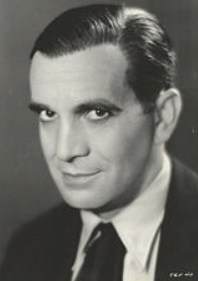 Although our lives overlapped––Jolson died at the age of 64 when I was 11––I never saw him perform in person. He was the first entertainer I knew about and heard, both on records and frequent radio performances, and it was clear from the way my family spoke about him that he was special, in a class by himself, when compared to other entertainers of the day (e.g., Eddie Cantor, Bing Crosby). I still play CDs of him singing. Some of the songs in his repertoire have never been sung better by anybody; Swanee [ https://www.youtube.com/watch?v=6TKaY39uasw ] this song, as sung by Jolson, helped make George Gershwin’s reputation (Judy Garland‘s version is also indelible), Mammy, You Made Me Love You (rivaled, again, by Garland), April Showers [https://www.youtube.com/watch?v=dLoCQzzIo7Q], California Here I Come, and dozens more. The fact that he was in the first motion picture with sound, The Jazz Singer,
Although our lives overlapped––Jolson died at the age of 64 when I was 11––I never saw him perform in person. He was the first entertainer I knew about and heard, both on records and frequent radio performances, and it was clear from the way my family spoke about him that he was special, in a class by himself, when compared to other entertainers of the day (e.g., Eddie Cantor, Bing Crosby). I still play CDs of him singing. Some of the songs in his repertoire have never been sung better by anybody; Swanee [ https://www.youtube.com/watch?v=6TKaY39uasw ] this song, as sung by Jolson, helped make George Gershwin’s reputation (Judy Garland‘s version is also indelible), Mammy, You Made Me Love You (rivaled, again, by Garland), April Showers [https://www.youtube.com/watch?v=dLoCQzzIo7Q], California Here I Come, and dozens more. The fact that he was in the first motion picture with sound, The Jazz Singer, 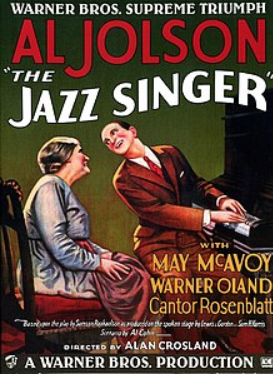 released in 1927, assured Jolson‘s place in history. In some ways, The Jazz Singer, mirrors his own life. Asa Yoelson was born in 1886 in the Jewish village of Srednick, in Lithuania, then part of the Russian Empire. His father, a rabbi and cantor, moved to New York in 1891, eventually finding work as a cantor in a synagogue in Washington, D.C., where the family was reunited. Jolson‘s mother died when he was just nine years old and, by many accounts, Jolson was significantly depressed for many months and had significant behavioral issues. He spent time at the St. Mary’s Industrial School for Boys, a progressive reformatory/home for orphans run by the Xaverian Brothers in Baltimore (Babe Ruth would attend the same school years after Jolson). By 1897 he was earning money, along with his brother Hirsch, by singing on street corners. In 1902, at the age of 16, he was a full-time performer.
released in 1927, assured Jolson‘s place in history. In some ways, The Jazz Singer, mirrors his own life. Asa Yoelson was born in 1886 in the Jewish village of Srednick, in Lithuania, then part of the Russian Empire. His father, a rabbi and cantor, moved to New York in 1891, eventually finding work as a cantor in a synagogue in Washington, D.C., where the family was reunited. Jolson‘s mother died when he was just nine years old and, by many accounts, Jolson was significantly depressed for many months and had significant behavioral issues. He spent time at the St. Mary’s Industrial School for Boys, a progressive reformatory/home for orphans run by the Xaverian Brothers in Baltimore (Babe Ruth would attend the same school years after Jolson). By 1897 he was earning money, along with his brother Hirsch, by singing on street corners. In 1902, at the age of 16, he was a full-time performer.
This posting is about Lady Gaga, not Jolson, so, if you want to learn more about this great American showman, see The Jazz Singer or see both biographical films about Jolson, The Jolson Story from 1946 and Jolson Sings Again from 1949. Although not completely accurate, these are all wonderful movies and well worth the time.
During the Vegas show Lady Gaga changed from one spectactular outfit to 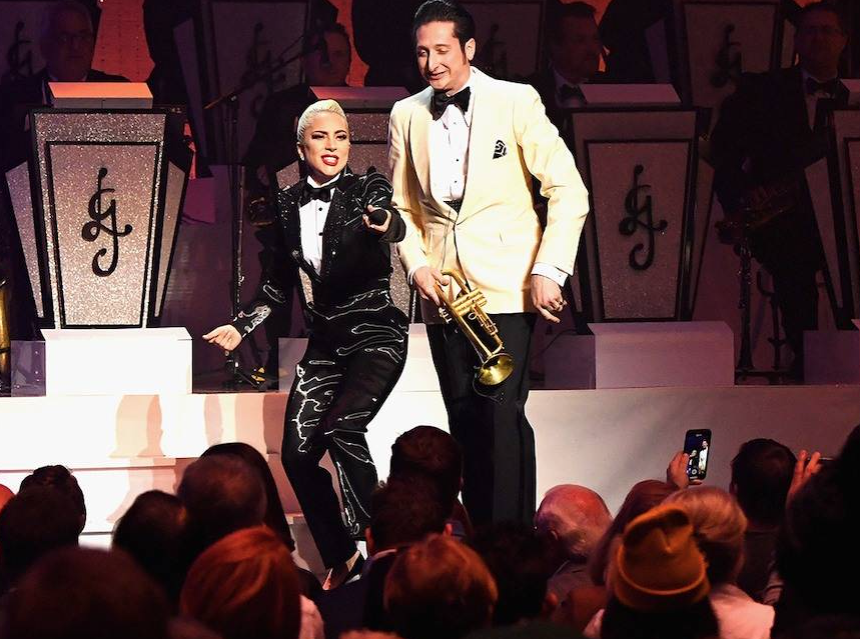 another––four changes in all.
another––four changes in all.

 While she was offstage large screens on each side of the 5,000 seat theater showed films of her talking about how she came to love jazz, about some of the composers she admires, about her enormous affection for, and debt to, Tony Bennett and, particularly, about her determination to keep American Jazz alive and before the public. My great love for Beethoven, Bach, Brahms, Dvorak and so many classical composers is certainly rivalled by my love of the music of Cole Porter, George and Ira Gershwin, Harold Arlen, Rodgers and Hammerstein, Jerome Kern, Frank Loesser etc., so this made my enthusiasm for Lady Gaga increase exponentially.
While she was offstage large screens on each side of the 5,000 seat theater showed films of her talking about how she came to love jazz, about some of the composers she admires, about her enormous affection for, and debt to, Tony Bennett and, particularly, about her determination to keep American Jazz alive and before the public. My great love for Beethoven, Bach, Brahms, Dvorak and so many classical composers is certainly rivalled by my love of the music of Cole Porter, George and Ira Gershwin, Harold Arlen, Rodgers and Hammerstein, Jerome Kern, Frank Loesser etc., so this made my enthusiasm for Lady Gaga increase exponentially.
When I write various postings for this blog page I tend to include what I consider interesting trivia. Hearing Lady Gaga talk about her devotion to keeping jazz music alive I realize that I feel similarly about my “trivia” type of information. I mostly think of myself as a teacher and, to paraphrase Henry Adams, I’m never quite sure of where my influence stops. Lady Gaga also noted that the Jazz and Piano concerts sold out faster than the Enigma concerts.
[Trivia #1: a slight diversion to talk about the two Jolson biographical films. These are marvelous movies that, in their time, were enthusiastically received and praised by critics. Jolson was played by Larry Parks (Samuel Klausman Lawrence Parks),  a fine American stage and movie actor; he received an Academy Award nomination for The Jolson Story––Jolson did the actual singing. Parks acted in more than 50 movies, including some other important productions, and was destined for a major career. He is almost completely unknown today because he was professionally destroyed by the McCarthy era blacklisting. Acknowledging he had once been a member of the Communist Party (as so many patriotic Americans were in the pre-WWII years), he was forced to testify before the House Un-American Activities Committee. Misled by studio executives to believe his own career would survive, he named of some of his Party acquaintances. Despite the excellence of both The Jolson Story and Jolson Sings Again, neither is likely to be seen on television or in a theater; Parks is almost unknown today and, also, he appears in blackface, a common practice for a vaudeville entertainer in Jolson‘s time. Larry Parks eventually formed a successful construction company in Los Angeles and built many apartment buildings which he managed, earning a great deal of money. He died of a heart attack in 1975.]
a fine American stage and movie actor; he received an Academy Award nomination for The Jolson Story––Jolson did the actual singing. Parks acted in more than 50 movies, including some other important productions, and was destined for a major career. He is almost completely unknown today because he was professionally destroyed by the McCarthy era blacklisting. Acknowledging he had once been a member of the Communist Party (as so many patriotic Americans were in the pre-WWII years), he was forced to testify before the House Un-American Activities Committee. Misled by studio executives to believe his own career would survive, he named of some of his Party acquaintances. Despite the excellence of both The Jolson Story and Jolson Sings Again, neither is likely to be seen on television or in a theater; Parks is almost unknown today and, also, he appears in blackface, a common practice for a vaudeville entertainer in Jolson‘s time. Larry Parks eventually formed a successful construction company in Los Angeles and built many apartment buildings which he managed, earning a great deal of money. He died of a heart attack in 1975.]
Judy Garland
Jolson was succeeded as the “greatest entertainer” by Judy Garland. Her name will likely last far longer than Jolson‘s because of her role as Dorothy in the 1939 film The Wizard of Oz. Although it was made 80 years ago, the same year I was born, this film remains a favorite through the generations; it is actually being shown on the big screen at a theater close to my home this week.
[Trivia #2: 1939 is often referred to as Hollywood’s greatest year; in addition to The Wizard of Oz, the other nine films nominated for the Academy Award were Gone With The Wind (the winner), Stagecoach (the film that made John Wayne a star), Mr. Smith Goes to Washington (Jimmy Stewart as a moral force in Washington, D.C. – this should be required viewing in every civics class in the country, if there still were civics classes …), Wuthering Heights (one of the great romantic films despite the fact that the two leading actors, Laurence Olivier and Merle Oberon, disliked each other), Ninotchka (the magnificent Greta Garbo in a particularly delightful and witty role), Dark Victory (Bette Davis in a four hankie film), Goodbye, Mr. Chips (one of the warmest, most wonderful of films with a great performance by Robert Donat), Love Affair (another four hankie film and the only one of these ten to have been remade more than once and successfully: 1957’s An Affair to Remember with Cary Grant and Deborah Kerr and 1993’s Sleepless in Seattle, with Tom Hanks and Meg Ryan) and Of Mice and Men (from the John Steinbeck story and starring Burgess Meredith and Lon Chaney, Jr.).

Garland was literally a toddler when she started in vaudeville. She went on to become one of the greatest film and stage performers in history. Perhaps most remembered for her singing on film (Over the Rainbow from Oz, The Trolley Song from Meet Me In St. Louis, and so many others, but the The Man That Got Away number in A Star is Born [ https://www.youtube.com/watch?v=UzyPMRo8ZUQ ] is extraordinary- in my eyes the greatest jazz performance ever filmed)  and in concerts, as well as hit recordings. She achieved fame with her many musicals (Meet Me in St. Louis, The Harvey Girls, Babes in Arms and others) and for the Andy Hardy films with Mickey Rooney. Less mentioned is the fact that she was a brilliant, serious actress. She is, of course marvelous in The Wizard of Oz, but her performances in A Star is Born, in Judgement at Nuremburg and in A Child is Waiting are breathtaking. When she didn’t win the Academy Award for A Star is Born (Grace Kelly won for The Country Wife) Groucho Marx declared her loss as “the biggest robbery since Brinks.” TIME magazine labelled that performance as “just about the greatest one-woman show in modern movie history” – she did win a Golden Globe award that year. In 1999 the American Film Institute placed her among the ten greatest female stars of classic American cinema.
and in concerts, as well as hit recordings. She achieved fame with her many musicals (Meet Me in St. Louis, The Harvey Girls, Babes in Arms and others) and for the Andy Hardy films with Mickey Rooney. Less mentioned is the fact that she was a brilliant, serious actress. She is, of course marvelous in The Wizard of Oz, but her performances in A Star is Born, in Judgement at Nuremburg and in A Child is Waiting are breathtaking. When she didn’t win the Academy Award for A Star is Born (Grace Kelly won for The Country Wife) Groucho Marx declared her loss as “the biggest robbery since Brinks.” TIME magazine labelled that performance as “just about the greatest one-woman show in modern movie history” – she did win a Golden Globe award that year. In 1999 the American Film Institute placed her among the ten greatest female stars of classic American cinema.
We heard Judy Garland sing live in an outdoor stadium in Flushing Meadow, Queens, New York. It was the late 1960s. I was a still a resident at Mount Sinai. I don’t remember what the tickets cost but it was a significant, albeit not overwhelming, expenditure for us. It was an 8 PM concert and we, and almost everyone else attending, were in our seats before 7:30. At 8 nothing was happening. At 8:30 nothing was happening. At 9 nothing was happening. In most settings the audience would be more than restless, they would be clapping or shouting, stamping their feet, or getting up and leaving. Her audiences loved her without condition. It was well known that Judy didn’t start on time and nobody in that place was concerned. At 9:20 the orchestra started playing Over the Rainbow and high voltage electricity spread through the crowd. Even now, a half-century later, I can still feel it. A few minutes later she was onstage and the applause and cheering, the pure joy, went on and on and on. When she started singing there was complete silence. I think most people stopped breathing for a while. She sang until almost 1 AM, more than three hours with multiple encores, and no one left early.
After all, it was Judy Garland.
Live.
Singing.
Judy Garland (Frances Ethel Gumm) was born in Grand Rapids, Minnesota in 1922. One of the many semi-biographical songs for which she was famous was I Was Born in a Trunk, reflecting the fact that she was a seasoned stage performer when she was 2 years old. This commentary won’t review her entire, complicated, too short life and career––Wikipedia and various biographies can easily be found––except to note that her’s was a troubled life. A celebrity when she was a teenager, she was constantly criticized by film executives who thought she was not attractive and who constantly compared her to the other, prettier, young woman breaking into movies, Deanna Durbin. Into adulthood Garland struggled with alcoholism and substance abuse, as well as financial instability; she often owed hundreds thousands of dollars in back taxes.
After a serious period of depression in 1950-51, during which she was particularly befriended by Bing Crosby, she began a four-month tour of England, Scotland and Ireland where she played to sold-out audiences. She centered her performances as tributes to Al Jolson, singing many of the songs he made famous. After her great success at London’s Palladium Theater she continued her tour at New York’s Palace Theater with record-breaking sales and rave reviews. Ten years later, on April 23, 1961, she gave a concert at Carnegie Hall; that appearance was called “the greatest night in show business history.” If you want to hear the best of Judy Garland, listen to the Carnegie Hall recording.
Garland was always generous in acknowledging her debt to composers, to her orchestras and their conductors and, also, in many of her choices of music, to her professional ancestors, not the least of whom was Jolson.
She died of what was determined to be accidental barbiturate overdose at 47, in 1969, a few months after her fifth marriage. It is far from hyperbolic to note that legions of her fans stood outside the New York funeral home where services for her were held. James Mason, who played Norman Maine opposite her Vicki Lester in A Star is Born, said, in his eulogy, “Judy’s great gift was that she could wring tears out of hearts of rock.” He went on to say, “She gave so richly and so generously that there was no currency in which to repay her.” Michel Legrand, one of the most illustrious film composers, created dozens of haunting, romantic melodies; The Umbrellas of Cherbourg (1964) – I Will Wait for You, The Thomas Crown Affair (1968) – The Windmills of Your Mind, The Summer of ’43 (1971) – A Summer Place, Best Friends (1982) – How Do You Keep the Music Playing, Yentl (1983) – Papa Can You Hear Me? and many others. In 2010, when Legrand was almost 80, he was asked if he had any regrets over his long life. He said he was sorry he had not learned more languages so he could better enjoy other cultures and, also, “I would have liked to work with Judy Garland.”
Frank Sinatra
Frank Sinatra died 21 years ago, recently enough so that he is still well known to many people today. Sinatra was extraordinarily talented as a singer and, in mid-career after a dip in his musical popularity, he earned the best supporting actor award from the Academy of Motion Picture Arts and Sciences for his unforgettable 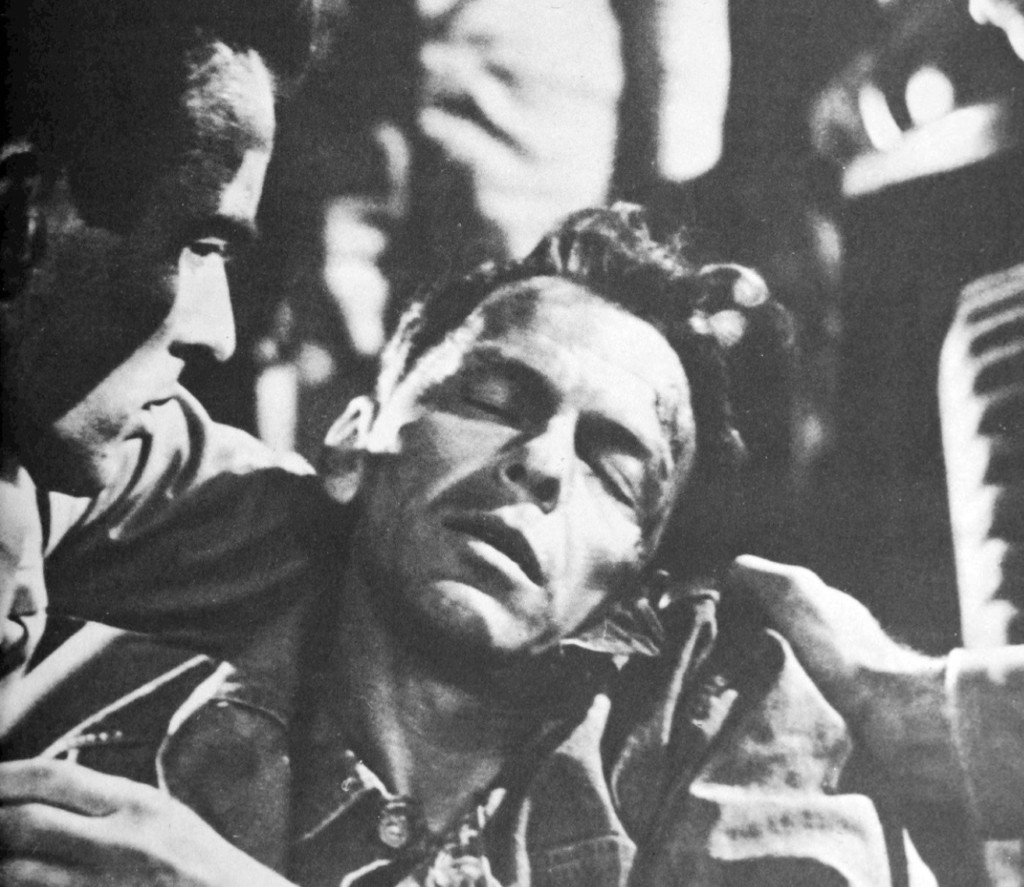 performance as Private Maggio in From Here to Eternity. In his prime, he was known throughout the world, able to reach vast audiences, in part because of sophisticated telecommunications that were unthought of in the time of Jolson and Garland and also because of modern jet travel which enabled him to give concerts throughout the world. He is one of best-selling recording artists of all time. Over the years his voice grew “darker” but it was his intonations, his phrasing and his delivery that captivated so many over the course of his long career. PBS will occasionally air one or more of his concerts as a part of their fund-raising week efforts. It is almost impossible to not watch him. He never learned to read music and he loved classical music and, yet, was one of the greatest jazz singers of all time.
performance as Private Maggio in From Here to Eternity. In his prime, he was known throughout the world, able to reach vast audiences, in part because of sophisticated telecommunications that were unthought of in the time of Jolson and Garland and also because of modern jet travel which enabled him to give concerts throughout the world. He is one of best-selling recording artists of all time. Over the years his voice grew “darker” but it was his intonations, his phrasing and his delivery that captivated so many over the course of his long career. PBS will occasionally air one or more of his concerts as a part of their fund-raising week efforts. It is almost impossible to not watch him. He never learned to read music and he loved classical music and, yet, was one of the greatest jazz singers of all time.
After years of making movie musicals––including the highly rated On the Town, with music by Leonard Bernstein and directed by Gene Kelly, who co-starred––Sinatra appeared in more serious and notable films (e.g., The Man With the Golden Arm for which he earned an Academy Award nomination for his vivid portrayal of a heroin addict in withdrawal, Not as a Stranger based on the Morton Thompson novel , Suddenly, posing as a psychopathic killer, The Manchurian Candidate, Some Came Running, based on the James Jones novel, von Ryan’s Express, and more, including acting as various detectives). He also made many light comedies (e.g. The Tender Trap, Young at Heart, A Hole in the Head, which introduced the hit song High Hopes) and appeared in sophisticated musicals (High Society, with Bring Crosby and Grace Kelly, Pal Joey, for which he won a Golden Globe, Can-Can and more).
Francis Albert Sinatra was born in Hoboken, New Jersey in 1915 and died in Los Angeles in 1998. His story is filled with meteoric successes, including his spectacular, record-breaking (my mother was one of the tens of thousands who went to see him) run at Broadway’s (long-defunct) Paramount Theater in 1942, starting the “Sinatramania” years. In between he had major slumps. In his many years in the public eye he was reported to be closely linked to the Mafia, had four marriages and even more public romances, worked and recorded with some of the greatest American and international names in music (Duke Ellington, Ella Fitzgerald, Judy Garland, Charles Aznavour, Antonio Jobim, Dean Martin, Sammy Davis, Jr., Lena Horne and many. many others). Unfailingly generous, he supported many friends when they were in need. He was a perfectionist and would occasionally cancel a recording session because his voice didn’t feel quite right, then he would pay the musicians out of his own pocket. He mostly kept his many financial contributions quiet. Sinatra was an active and important supporter of the civil rights movement in the 1960s. A long-time Democrat (campaigning for Truman, Stevenson, and Kennedy, seen here with Eleanor Roosevelt)
went to see him) run at Broadway’s (long-defunct) Paramount Theater in 1942, starting the “Sinatramania” years. In between he had major slumps. In his many years in the public eye he was reported to be closely linked to the Mafia, had four marriages and even more public romances, worked and recorded with some of the greatest American and international names in music (Duke Ellington, Ella Fitzgerald, Judy Garland, Charles Aznavour, Antonio Jobim, Dean Martin, Sammy Davis, Jr., Lena Horne and many. many others). Unfailingly generous, he supported many friends when they were in need. He was a perfectionist and would occasionally cancel a recording session because his voice didn’t feel quite right, then he would pay the musicians out of his own pocket. He mostly kept his many financial contributions quiet. Sinatra was an active and important supporter of the civil rights movement in the 1960s. A long-time Democrat (campaigning for Truman, Stevenson, and Kennedy, seen here with Eleanor Roosevelt)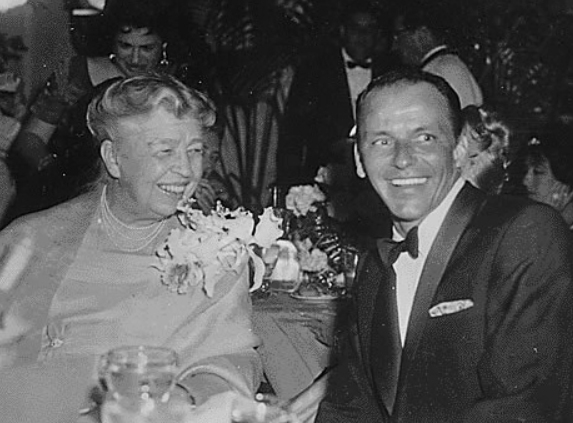 he changed his affiliation and supported Nixon in the 1970s. His awards are too numerous to mention and his entire story would take a book to tell. When he died the lights on the Empire State Building were turned blue (he was called “old blue eyes”) and the Las Vegas strip lights dimmed. The Encyclopedia Britannica said he was ” … the greatest American singer of 20th century popular music … he transcended the status of mere icon to become one of the most recognizable symbols of American culture.”]
he changed his affiliation and supported Nixon in the 1970s. His awards are too numerous to mention and his entire story would take a book to tell. When he died the lights on the Empire State Building were turned blue (he was called “old blue eyes”) and the Las Vegas strip lights dimmed. The Encyclopedia Britannica said he was ” … the greatest American singer of 20th century popular music … he transcended the status of mere icon to become one of the most recognizable symbols of American culture.”]
Barbra Streisand.
We saw Barbra Streisand in person twice. In June 1962, a few days after our marriage, Kate and I saw I Can Get it for you Wholesale, on Broadway. The musical comedy was a big hit particularly because of the young supporting actor,  Streisand, who played Miss Marmelstein. “She stopped the show cold.”
Streisand, who played Miss Marmelstein. “She stopped the show cold.”
The second time we saw her was the last time we were in Las Vegas, New Year’s Day, 1994, when she performed after many years away from the concert stage.
Barbara Joan Streisand––she changed her name to Barbra when she began her career–– was born in Brooklyn, New York in April 1942, almost exactly three years after I was born. We grew up in the same neighborhood. When I was at Brooklyn College in the late 1950s it was known that there was an incredibly talented Erasmus Hall High School student.
In Streisand‘s six-decade career as a singer, actress, filmmaker and song writer she has been awarded two Academy Awards (for acting in Funny Girl and for composing Evergreen for A Star is Born––the first woman to be so honored), ten Grammy Awards, five Emmy Awards, a special Tony Award, an American Film Institute Award, a Kennedy Center Honors prize, four Peabody Awards, the Presidential Medal of Honor and nine Golden Globe awards. She has been a movie actress, a producer and a director. With Yentl, in 1983, she became the first woman to write, produce, direct and star in a major studio film.
One of the best-selling recording artists of all time, she is known throughout the world. Her grandparents came from eastern Europe, where her maternal grandfather had been a cantor.
After Miss Marmelstein she played the legendary 1920s entertainer Fanny Brice in Funny Girl, the Broadway show that made her a superstar. She went on to make the movie Funny Girl, for which she won both the Academy Award and the Golden Globe. Some of the other wonderful films in which she starred are Hello, Dolly!, Funny Lady (a sequel to Funny Girl), The Prince of Tides (1992 Academy Award for best picture, which she directed) and (my favorite Streisand film, also starring Robert Redford), The Way We Were.
for which she won both the Academy Award and the Golden Globe. Some of the other wonderful films in which she starred are Hello, Dolly!, Funny Lady (a sequel to Funny Girl), The Prince of Tides (1992 Academy Award for best picture, which she directed) and (my favorite Streisand film, also starring Robert Redford), The Way We Were.
Barbra Streisand is a legend because of her recordings, her television specials and guest appearances, her films and her concerts, and these comments will be brief. As with other great artists she always acknowledges her professional forebears, especially Fannie Brice and Judy Garland, and has often been compared to both. Streisand was invited to appear as a guest on Garland‘s 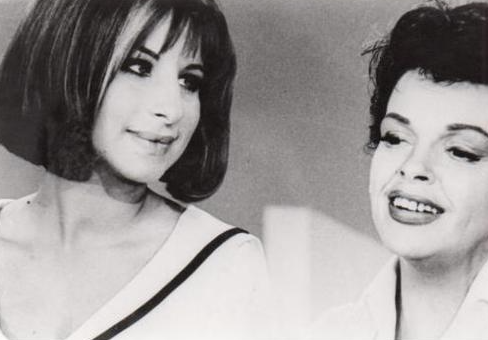 television show when Streisand was beginning her career; they joke about Streisand being a challenger to Garland. Their duet is jazz at its best as they turn Get Happy and Happy Days are Here Again into a thrilling and unforgettable modern fugue
television show when Streisand was beginning her career; they joke about Streisand being a challenger to Garland. Their duet is jazz at its best as they turn Get Happy and Happy Days are Here Again into a thrilling and unforgettable modern fugue
[https://www.bing.com/videos/search?q=judy+garland+and+streisand+duet&view=detail&mid=A0FAF2CEFB807D5DF149A0FAF2CEFB807D5DF149&FORM=VIRE].
Politically active as a liberal democrat (she grew up in Brooklyn in the post-WWII years, after all), her version of Happy Days are Here Again became the de facto campaign song in the Clinton years.
Lady Gaga
Stefani Joanne Angelina Germanotta (she composes music as Stefani Germanotta) was born in New York City in 1986. As Lady Gaga she has already become an iconic American singer, songwriter and actress, known for her unconventional and provocative renditions as well as her visual experiments in choices of attire, staging and lighting.
Lady Gaga is keenly aware of those who have gone before, never failing to acknowledge Tony Bennett and others. Before she came on stage for her Jazz and Piano concert you hear recordings of Frank Sinatra singing some of his best-known songs, followed by Tony Bennett singing his. Her last number, performed as an encore, was New York, New York, which was originally sung by Judy Garland‘s daughter, Liza Minelli, and popularized by Sinatra. As with other great entertainers Lady Gaga also regularly acknowledges those who wrote the music she sings as well as the other musicians on stage with her.
She’s not yet 33 years old and it may be premature to regard her as one the greatest of entertainers but, I think not, particularly as she gives more attention to the world of jazz. The songs of the last century are timeless but, increasingly, are only rarely heard; it’s no accident that the same music appears in the repertoires of Al Jolson, Judy Garland, Frank Sinatra, Barbra Streisand and, now, Lady Gaga. Each version distinctive, recognizable and decidedly memorable. Perhaps it’s also no accident that Garland, Streisand and Lady Gaga each played in a version of A Star is Born (The original A Star is Born, in 1937, starred the wonderful Janet Gaynor as the first Esther Blodgett/Vicki Lester).
Although we don’t think of entertainers as philosophers, Jolson and the others had very strong ideas about the mood and the message they wanted to project, the songs they wanted to sing and the ways they wanted to sing it. Lady Gaga is very much in control of what she wants to do. In some of the numbers she sang with the full orchestra, sometimes with the trombonist or the trumpeter, sometimes a solo piano. But she is herself a gifted pianist and quite a few songs were just her and the keyboard; they were some of the best.
Where do we fit Tony Bennett, Bing Crosby, Sammy Davis, Jr., Diana Ross, Lena Horne, Nat King Cole and dozens of other marvelous singers and entertainers? None of them had the broad multidiscipline success of Jolson and the others I’ve cited, none of them reached as many people, none of them left as indelible a mark; they are in the “not quite” group of extraordinary entertainers but are clearly part of “the greatest jazz singer” group along with Mel Tormé, Ella Fitzgerald, Dinah Washington, Billy Holliday, Fred Astaire, Charles Aznavour, Vera Lynn, Nana Mouscouri, Diana Krall and many others.
Being unbiased is not my forte and my musical tastes are certainly limited. I realize other names that could be considered are Michael Jackson, Beyoncé, David Bowie, Elvis, Freddie Mercury, The Beatles and others. Most use their own music or music that generally doesn’t particularly appeal to me and, with the exception of The Beatles, who were an enormous influence on all music that came after them, I’m not familiar with them. Lady Gaga is already recognized by millions of people around the world, particularly with the release of her version of A Star is Born. If she continues to promote classical jazz she will pull millions more into her circle of fans.
There are no score cards on this matter and there is no such thing as the best of the best. Also, with a more international view, many other names should appear.
Still, for me, Judy Garland …
Reviews of Jazz and Piano:
https://variety.com/2019/music/news/lady-gaga-jazz-and-piano-las-vegas-concert-review-1203113496/
https://www.latimes.com/entertainment/music/la-et-ms-lady-gaga-enigma-jazz-piano-las-vegas-review-20190121-story.html
January 29, 2019 at 5:42 pm
fantastic review of wonderful and very talented entertainers. thank you for summarizing so much of history and bringing joy with the reflection of so much talent.
January 29, 2019 at 8:29 pm
What a wonderful walk down the musical memory lane! I had to constantly stop reading your engaging text to watch the performance videos. You remind us how lucky we are to have had these performers in our lives and to still be able to enjoy them even long after many are gone.
January 29, 2019 at 11:30 pm
When I was in College, I & a friend (whose Uncle was Sinatra’s partner in a casino) had a job as driver, bellhop, parking lot attendant & “shil” at Sinatra owned Cal-Neva lodge at Northshore, Lake Tahoe. The summer I was there (1963), Sinatra, Dean Martin, Tony Bennet, Ella Fitagerald, Sammy Davis,Eddie Fisher, and Vic Damone were performing. They were all great performers.
My favorite male vocalist is Sinatra, who mesmerized his audience nightly and the favorite
female vocalist was Ella Fitzgerald (with close behind Judy Garland and Barbra Streisand).
You barely mentioned Diana Krall, who is talented Jazz pianist and vocalist present times, who deserves present day talent awards and a very good and talented male Jazz singer today, Michael Buble.
Your musings and writings are great and appreciated.
February 4, 2019 at 8:16 am
Great discussion on entertainers! You alluded to Freddie Mercury at the end. He had the audience in the palm of his hand during his Live Aid Concert. My older brother was lucky to see him in concert when Queen visited Houston around 1980 or so.
February 5, 2019 at 4:35 pm
Hello. Please add my address to your mailing list. Many thanks. Patricia